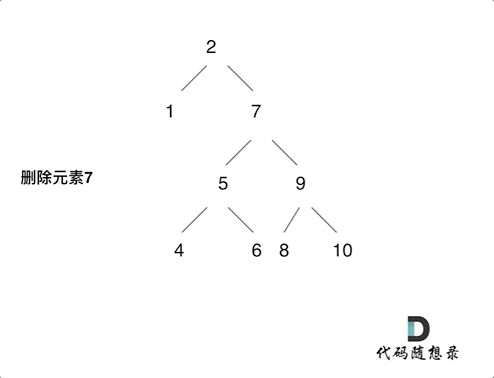本文最后更新于:2022年9月21日 凌晨
给定一个二叉搜索树的根节点 root 和一个值 key,删除二叉搜索树中的 key 对应的节点,并保证二叉搜索树的性质不变。返回二叉搜索树(有可能被更新)的根节点的引用。
一般来说,删除节点可分为两个步骤:
- 首先找到需要删除的节点;
- 如果找到了,删除它。
说明: 要求算法时间复杂度为 O(h),h 为树的高度。
示例:
1
2
3
4
5
6
7
8
9
10
11
12
13
14
15
16
17
18
19
20
21
22
23
24
25
26
| root = [5,3,6,2,4,null,7]
key = 3
5
/ \
3 6
/ \ \
2 4 7
给定需要删除的节点值是 3,所以我们首先找到 3 这个节点,然后删除它。
一个正确的答案是 [5,4,6,2,null,null,7], 如下图所示。
5
/ \
4 6
/ \
2 7
另一个正确答案是 [5,2,6,null,4,null,7]。
5
/ \
2 6
\ \
4 7
|
Solution
参考:《算法小抄》3.4
- 删除一个节点有三种情形:
- 该节点左右子节点都为空,直接删除
- 该节点有一个非空子节点,让这个孩子直接接替
- 该节点有两个子节点,可以选择让右子树中的最小节点来代替
1
2
3
4
5
6
7
8
9
10
11
12
13
14
15
16
17
18
19
20
21
22
23
24
25
26
27
|
class Solution:
def deleteNode(self, root: TreeNode, key: int) -> TreeNode:
if not root: return
if root.val==key:
if not root.left: return root.right
if not root.right: return root.left
minNode = self.getMinNode(root.right)
root.val = minNode.val
root.right = self.deleteNode(root.right, minNode.val)
elif root.val < key:
root.right = self.deleteNode(root.right, key)
elif root.val > key:
root.left = self.deleteNode(root.left, key)
return root
def getMinNode(self, root):
while root.left:
root = root.left
return root
|
cpp
1
2
3
4
5
6
7
8
9
10
11
12
13
14
15
16
17
18
19
20
21
22
23
24
25
26
27
28
29
30
31
32
33
34
35
36
37
38
39
40
41
42
43
44
45
46
47
48
49
50
51
52
53
|
class Solution {
public:
TreeNode* deleteNode(TreeNode* root, int key) {
if(root==nullptr) return root;
if(root->val < key){
root->right = deleteNode(root->right, key);
return root;
} else if(root->val > key){
root->left = deleteNode(root->left, key);
return root;
} else {
if(root->left==nullptr)
return root->right;
if(root->right==nullptr)
return root->left;
TreeNode* successor = new TreeNode(getMin(root->right)->val);
successor->right = removeMin(root->right);
successor->left = root->left;
return successor;
}
}
TreeNode* getMin(TreeNode* root){
while(root->left){
root = root->left;
}
return root;
}
TreeNode* removeMin(TreeNode* root){
if(root->left==nullptr){
TreeNode* rightNode = root->right;
delete root;
return rightNode;
}
root->left = removeMin(root->left);
return root;
}
};
|
| TreeNode* removeMin(TreeNode* root) {
TreeNode* cur = root, *pre = nullptr;
while (cur->left) {
pre = cur;
cur = cur->left;
}
if (pre){
pre->left = cur->right;
return root;
}
else
return root->right;
}
|
参考 代码随想录 ,另一种替代方法
- 对于左右孩子节点都不为空,则将删除节点的左子树头结点(左孩子)放到删除节点的右子树的最左面节点的左孩子上,返回删除节点右孩子为新的根节点。

1
2
3
4
5
6
7
8
9
10
11
12
13
14
15
16
17
18
19
20
21
22
23
24
25
| class Solution {
public:
TreeNode* deleteNode(TreeNode* root, int key) {
if (root == nullptr) return root;
if (root->val == key) {
if (root->left == nullptr) return root->right;
else if (root->right == nullptr) return root->left;
else {
TreeNode* cur = root->right;
while(cur->left != nullptr) {
cur = cur->left;
}
cur->left = root->left;
TreeNode* tmp = root;
root = root->right;
delete tmp;
return root;
}
}
if (root->val > key) root->left = deleteNode(root->left, key);
if (root->val < key) root->right = deleteNode(root->right, key);
return root;
}
};
|
java
1
2
3
4
5
6
7
8
9
10
11
12
13
14
15
16
17
18
19
20
21
22
23
24
25
26
27
28
29
30
31
32
| class Solution {
public TreeNode deleteNode(TreeNode root, int key) {
if (root == null) {
return root;
}
if (root.val == key) {
if (root.left == null && root.right == null) {
return null;
}
if (root.left == null || root.right == null) {
return root.left == null ? root.right : root.left;
}
TreeNode node = root.right;
while (node.left != null) {
node = node.left;
}
node.left = root.left;
root.left = null;
return root.right;
}
if (root.val > key) {
root.left = deleteNode(root.left, key);
}
if (root.val < key) {
root.right = deleteNode(root.right, key);
}
return root;
}
}
|
